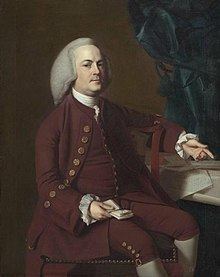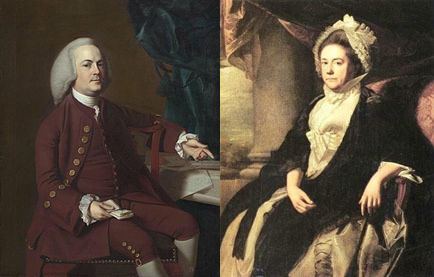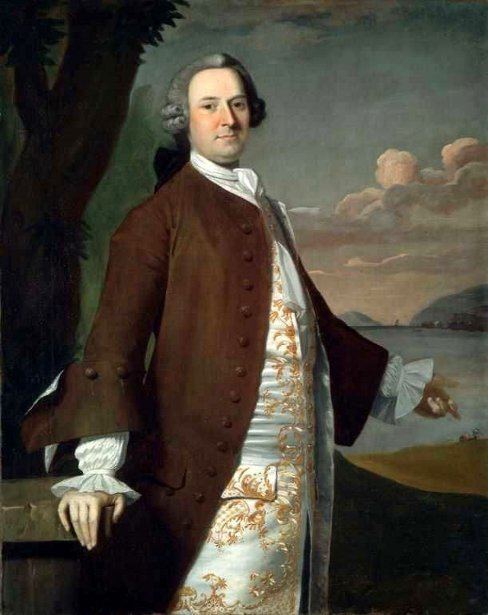Name Isaac Jr. | Died 1781, England | |
 | ||
Isaac Royall Jr. (1719–1781) was a colonial American landowner who played an important role in the creation of Harvard Law School.
Contents
Life

Royall Jr. was the son of Squire Isaac Royall Sr. (1677-1739) an Antiguan plantation owner, slave trader, and justice of the peace. Coming from humble circumstances in North Yarmouth in what was then Massachusetts and now Maine, the elder Royall's family moved to Dorchester, Massachusetts, to avoid Indian attacks. Royall Sr. subsequently made his fortune in the trade of slaves, rum, and sugar; in 1700, at age 23, Royall's father moved to Antigua and was the part owner of a Massachusetts slaving ship. Isaac Royall Sr.'s son Isaac Jr. was born in Antigua in 1719; a daughter, Penelope Royall, was born there in 1724. The Royall family then faced turmoil: a bad drought in 1725, a massive hurricane in 1733, earthquakes in 1735, and both a smallpox epidemic and a slave revolt in 1736.

Due to these events, Royall Sr. decided to return to New England. Beginning in 1732, in anticipation of his move, Royall began purchasing a 500-acre estate in Charlestown, Massachusetts (now Medford) near the Mystic River, which he named Ten Hills Farm. In 1737, the family moved to the estate, bringing with them at least 27 African slaves. The estate includes three-story Georgian mansion (expanded from an earlier, more modest structure), a carriage house, a stable, an "out kitchen," and a number of barns. After Issac Sr. died in 1739, Isaac Jr., then twenty years old, inherited his father's estate, variously described as "immense" and "small but prosperous." Isaac Jr. inherited not only Ten Hills Farm (which is now the Isaac Royall House, a museum containing the only slave quarters in the northeast United States) but also eighteen of his father's slaves and his father's plantation in Antigua.

Royall thereafter became one of the colony's wealthiest men, and an active investor in real estate; he purchased silver from Paul Revere, traveled in a stagecoach with liveried servants, purchased fine china and furniture from abroad, and hosted lavish parties. In 1754, he owned 12 enslaved Africans, six times more than any other household. Royall held a number of civic offices, serving as justice of the peace, chairman of the Medford board of selectmen, and representative of Medford to the colonial legislature; he returned his salary to the town treasury. Royall was elected to the Governor's Council in 1752 (serving until 1774), held the honorary military rank of Brigadier General of the Province, and served as an overseer of Harvard College (along with Thomas Pownall). Royall also held pews at King's Chapel and Christ Church.
In 1738, Royall married Elizabeth McIntosh, then fifteen years old, the daughter of a friend of Royall's father. The marriage was advantageous and confirmed Royall's place in the colonial elite.
During the American Revolution, Royall apparently had Patriot sympathies but significant Loyalist connections. He fled Medford three days before the Battle of Lexington, abandoning his slaves to their freedom. Along with many others, Royall was named in the Massachusetts Banishment Act of 1778. He was unable to travel to Antigua so instead fled to Nova Scotia, where he remained for a year before moving to England, where he joined his daughters' families and died of smallpox in 1781.
There is a portrait of Royall by John Singleton Copley and another of his wife, Elizabeth. Robert Feke also painted a family group portrait which depicts him, his wife and his daughter. This daughter Harriet married into the Pepperell family and their daughter married a Palmer baronet in Wanlip in Leicestershire.
Royall's sister was Penelope Royall (1724-1800), who married Colonel Henry Vassall (the son of a Jamaican planter) in 1742; they moved to Cambridge.
Harvard Law School
In his will of 1779, Royall left land to Harvard College to establish the first professorship in law at the school. This bequest led to the founding of Harvard Law School in 1817.
In 1936, to celebrate the university's tercentenary, Harvard alumnus and former English professor Pierre de Chaignon la Rose drew seals for each of Harvard's graduate schools. For Harvard Law School, la Rose adopted Royall's coat of arms, a blue shield adorned with three sheaves of wheat. This seal was adopted by the Harvard Corporation. In 2016, the seal became the object of controversy due to Royall's slaveholding in Antigua, where he ordered 77 black enslaved persons be burned alive, and several others quartered. Students under the name 'Royall Must Fall' (fashioned after the Rhodes Must Fall Movement) organized to have the seal removed. After several incidents of unknown racial attacks within the Law School community, specifically the Black Tape Incident, Law School Dean Martha L. Minow was pressured by students to create a committee of students, faculty, staff, and alumni to recommend whether to change the seal. In 2016, Harvard Law School officially decided to scrap the seal that contained Royall's arms.
